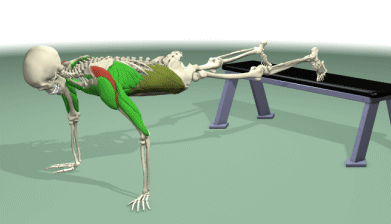





THE FITNESS
DIGEST.
You are one of the millions living with diabetes. And you want a great body. But how? Does the stringent, lifestyle-altering nature of this disease mean you cannot? Fortunately, the answer is that it is possible to craft a strong body – and there are people from all walks of life, from athletes to office workers who have successfully done just that. Actually, in many ways, the diabetic lifestyle is quite similar to the fitness lifestyle: Eating multiple small meals, counting carbs and calories, getting regular exercise and of course, using trial and error to find out what works best for you.
Diabetes forces you to lead a healthy lifestyle. It forces you to really be in tune with your body and make healthy choices – sleep right, eat right, exercise right. Successful diabetes management is all about balance. Balancing insulin, exercise and diet in such a way that you can live a full life and achieve whatever you set out to do.
Balancing Act
For the diabetic , controlling insulin levels, carb intake and exercise is critical, especially if your goals include building lean muscle and burning fat. By maintaining tight glycemic balance, you are more likely to have effective muscle mass gains while maximizing your fat losses. Dietary and insulin adjustments must be masterfully coordinated to ensure ideal conditions for fitness.
Insulin is an anabolic hormone, meaning that it assists anabolic processes such as the uptake of glucose in muscle and fat cells. If insulin levels are deficient for an extended time, loss of amino acids from muscle and muscle-wasting can occur.
On the other hand, taking too much insulin results in low blood glucose, which may stimulate your hunger and cause you to want to eat anything available to restore the balance – thus sending blood glucose levels soaring.
This cycle of chasing high blood glucose with extra insulin and treating low blood glucose with additional carbohydrates increases the risks of complications and can produce unwanted body fat. You have got to make precise insulin and carb adjustments to achieve an optimal blood glucose level for max performance in the gym. If you hit the gym and your sugar levels are too high or too low, you are going to have a weak workout.
In The Zone.
This is the zone, or range, that diabetic athletes try to stay within to ensure their ability to elicit the same kind of training adaptations as non-diabetics.Diabetic athletes have much more effective workouts if they begin training in a near-normal blood glucose range – 100-180 mg per dl. For optimal recovery from exercise, blood glucose levels should be maintained in a similar range.
Too much sugar in your bloodstream at the start of your training can lead to premature fatigue and sluggishness. After training, high sugar levels will prevent optimal muscle-fuel restoration. Effectively dealing with fluctuating blood glucose levels facilitates intense, potent training sessions.
Take a little extra insulin to pull your sugars back into the optimal training zone then eat a sandwich just before workout or drink some fruit juice as you train to keep your level at 180 for the duration of 30-40 minute workout. But be careful not to slam your sugars down too hard or too quickly because that can create a whole new set of problems.
Avoiding Hypo.
Prevention of hypoglycemia (less than 45 mg per dl is considered a low blood glucose level) is crucial to the diabetic exerciser, since lows may result in medical emergencies.
Test your blood glucose every two hours to find out how your body is functioning, determine the general trends, establish your patterns, and take note of relationships that exists between insulin, exercise and eating. This frequency of testing is especially necessary whenever you make changes to your training routine or diet, because many tests will allow you to establish solid baselines. Once you get that foundation, it will give you incredible freedom in terms of balancing food intake, exercise and insulin dosages.
It has been found that by making insulin adjustments – a cutback in the range of 50% - 80% of baseline dose at the beginning of a period of intense training – one is able to minimize the frequency and severity of his lows. Regular training reduces insulin requirements on all shots, not just the pre-exercise dose. However, that is if diet stays the same. When training hard, sometimes increase your caloric intake a little, so sometimes you can achieve balance with a 30 – 40% cutback.
Of course, this type of adjustment should only be made with the help of your physician and dietician, who can offer suggestions to help you achieve optimal balance.
If you do get caught with your sugars down, keep to the following suggestions:- :During a workout, consume 10 -15 grams of a rapidly absorbed carbohydrate such as glucose tablets or gel, sugary candy (not chocolate), fruit juice or regular soda. Wait 10 minutes, then retest. If you are near the end of your workout, that amount should be enough to raise your blood glucose levels sufficiently without causing them to skyrocket.
Determination and experience can provide the tools needed to keep your metabolism running smoothly. The challenge is that you never get a day of rest from testing or from thinking about caloric intake, insulin dosages or exercise. Keep a detailed written log. It is essential to record every detail about what exactly you did in the 2 – 3 hours before each test, what you are doing at the time of test, and what you are about to do following in terms of eating, sleeping, exercising, insulin injections and stress levels.
Diabetes & Exercise
Physical fitness Disclaimer and Waiver of liability:
Exercises are not without their risks and the exercise programs in this website may result in injuries.Any person who undertakes these exercises does so at their own risk.To reduce the risk of injuries ,you should consult your doctor before beginning these or any other exercise programs.As with any exercise program ,if at any point during your workout you believe conditions to be unsafe or begin to feel faint or dizzy,have physical discomfort or pain, you should stop immediately and consult a physician.
Daily exercise for Working women.
Jumping Jacks. . Effective workouts.
Group exercise and its benefits.
Calf raises-free style . Push ups.
Tummy exercises. Hoola Hooping .
Fitness Motivational tips. Barbell Squauts.
The myths of spot reduction. Leg press.
Standing calf raises. Concentration curls.
Bench (Tricep) dips.. One arm dumbbell rows.
Pec deck Flye. Fr0nt dumbbell raises. Glute ham raise.
Seated leg curl . Close grip bench press .
.

Please keep comments positive and constructive.
Help the WEBSITE by reporting inappropriate comments to thefitnessdigest@gmail.com . Inappropriate comments may be reported and/or removed.